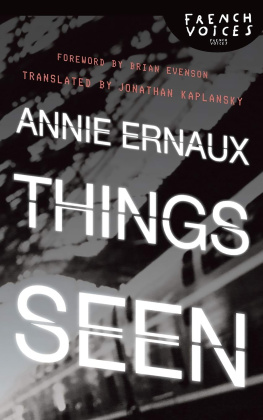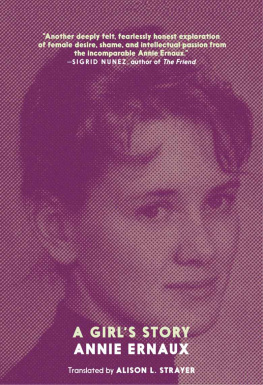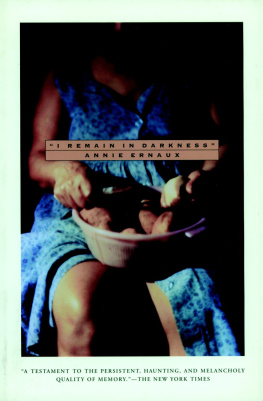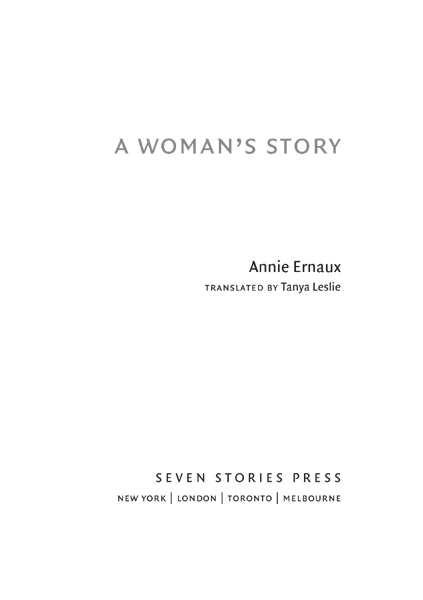Copyright 1988 by ditions Gallimard
English translation copyright 1991 by Seven Stories Press
Reading Group Guide 2003 by Seven Stories Press
All rights reserved. No part of this book may be reproduced, stored in a retrieval system, or transmitted in any form, by any means, including mechanical, electric, photocopying, recording, or otherwise, without the prior written permission of the publisher.
Seven Stories Press
140 Watts Street
New York, NY 10013
http://www.sevenstories.com/
In Canada: Hushion House, 36 Northline Road, Toronto, Ontario M4B 3E2
In the U.K.: Turnaround Publisher Services Ltd., Unit 3, Olympia Trading Estate, Coburg Road, Wood Green, London N22 6TZ
In Australia: Palgrave Macmillan, 627 Chapel Street, South Yarra VIC 3141
Library of Congress Cataloging-in-Publication Data
Ernaux, Annie, 1940
[Femme. English]
A womans story / Annie Ernaux ; translated by Tanya Leslie
p. cm.
eISBN: 978-1-60980-326-1
1. Ernaux, Annie, 1940 Family. 2. Authors, French20th centuryFamily relationships. 3. MothersFranceBiography. 4. Alzheimers disease. I. Title.
PQ2665.R67Z464213 2003
843.914dc21 2003009351
College professors may order examination copies of Seven Stories Press titles for a free six-month trial period. To order, fax on school letterhead to (212) 226-1411 or visit www.sevenstories.com/textbook/.
v3.1
Contents
It is said that contradiction is unthinkable; but the fact is that in the pain of a living being it is even an actual existence.
HEGEL
MY MOTHER DIED on Monday 7 April in the old peoples home attached to the hospital at Pontoise, where I had installed her two years previously. The nurse said over the phone: Your mother passed away this morning, after breakfast. It was around ten oclock.
For the first time the door of her room was closed. The body had already been washed and a strip of gauze had been wrapped around her head and under her chin, pushing all the skin up around her eyes and mouth. A sheet covered her body up to her shoulders, hiding her hands. She looked like a small mummy. The cot sides had been taken down and left on either side of the bed. I wanted to slip her into the white nightdress with a crochet border that she had once bought for her own funeral. The nurse told me one of the staff would see to this and would also take the crucifix my mother kept in her bedside drawer and place it on her chest. The two screws that pinned the copper arms on to the cross were missing. The nurse wasnt sure they could be replaced. It didnt matter, I wanted her to have her crucifix all the same. On the trolley stood the bunch of forsythia I had brought the day before. The nurse suggested I go straight to the administration office while they drew up an inventory of my mothers personal belongings. She had very few things of her own lefta suit, a pair of blue summer shoes, an electric shaver.
At the administration office, a young woman asked me what I wanted. My mother died this morning. Was she registered at the hospital or as a long-term patient? What was her name? She consulted a sheet of paper and gave a faint smile: she had already been informed. She went and fetched my mothers record and asked a few questions about her, where she was born, her last address before being admitted as a long-term patient. These details were probably in the file.
In my mothers room, a plastic bag with her belongings had been set aside on the bedside table. The nurse asked me to sign the inventory. I decided not to keep the clothes and other possessions shed had at the hospital. All I took was a small Savoyard chimney sweep from Annecy and a statuette she and my father had bought when they made the pilgrimage to Lisieux. Now that I was there, my mother could be taken to the hospital morgue (it was customary for the body of the deceased to remain in its room for a period of two hours following the time of death). As I was leaving, I caught sight of the woman who shared my mothers room. She was sitting in the sisters office, behind the glass partition, with her handbag in her lap. She had been asked to wait there until my mothers body was moved to the morgue.
My ex-husband went with me to the undertakers. Behind the wreaths of artificial flowers, a few armchairs were arranged around a coffee table with some magazines. An assistant took us into a room and asked us questions about when she had died, where the burial was to take place and whether or not we wanted a service. He wrote everything down on an order form, occasionally jabbing at a pocket calculator. Then he led us into a dark room with no windows and switched on the light. A dozen coffins were standing against the wall. The assistant explained: All our prices include tax. Three of the coffins were open so that customers could also choose the color of the lining. I settled for oak because it had been her favorite tree and because she had always wanted to know whether the furniture she bought was made of oak. My ex-husband suggested mauve for the lining. He was proud, almost happy to remember that she often wore blouses of the same color. I wrote out a check for the assistant. The firm took care of everything, except the supplying of flowers. I got home around midday and had a glass of port with my ex-husband. My head and my stomach started to ache.
Around five oclock I called the hospital to ask if I could go and see my mother at the morgue with my two sons. The girl on the switchboard told me it was too late, the morgue closed at half past four. I got out the car and drove around the new part of town near the hospital, trying to find a flower shop open on a Monday. I asked for white lilies but the florist advised against them: they were suitable only for children, possibly for young girls.
The burial took place on the following Wednesday. I arrived at the hospital with my two sons and my ex-husband. The morgue wasnt signposted and we lost our way before discovering the low, concrete building which lay on the edge of the fields. An assistant in a white coat was talking on the phone. He signaled to us to sit down in a corridor. We sat on chairs lined up against the wall, opposite the lavatories. Someone had left the door open. I wanted to see my mother once more and place on her breast the two twigs of japonica blossom I had brought with me. We didnt know whether they intended to show us the body one last time before closing the coffin. The undertakers assistant we had seen in the shop emerged from an adjoining room and graciously asked us to follow him. My mother was lying in the coffin, her head thrown back, her hands clasped together on the crucifix. The white gauze had been removed and she was wearing the nightdress with the crochet border. The satin shroud reached up to her chest. It was in a large, bare room with concrete walls. I dont know where the faint light came from.
The assistant informed us that the visit was over and he led us back into the corridor. I felt that he had shown us my mother simply to prove that his firm had carried out its duties satisfactorily. We drove through the new part of town until we reached the church, which had been built next to the arts center. The hearse hadnt arrived so we waited in front of the church. Across the street, someone with tar had smeared Money, consumer goods, and the State are the three pillars of apartheid on the faade of the supermarket. A priest stepped forward. He addressed me in affable tonesWas she your mother?and asked my sons where they went to university and what they were studying.






